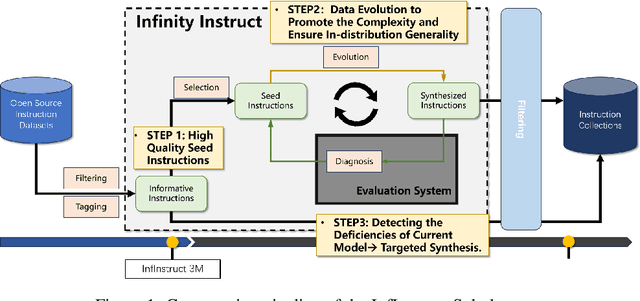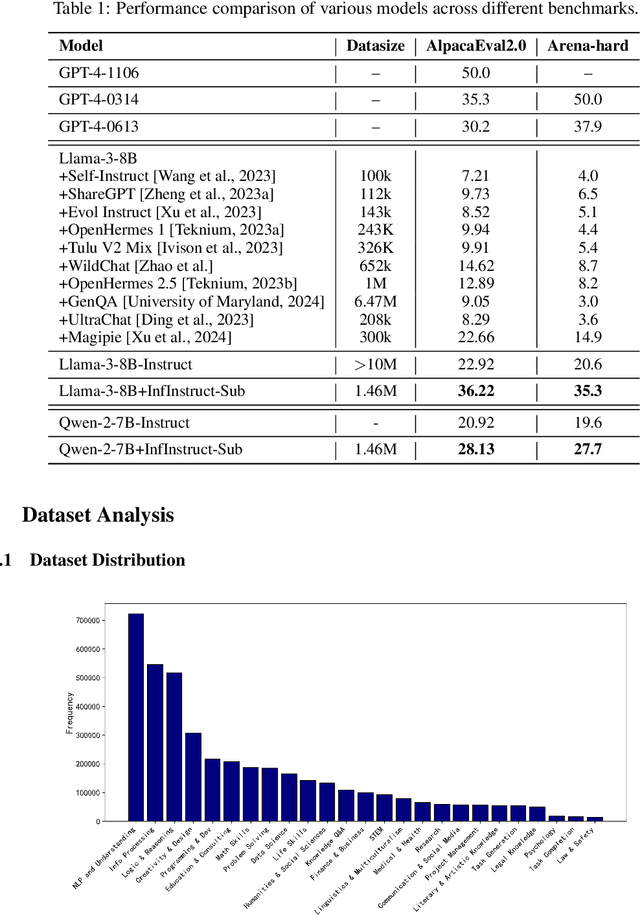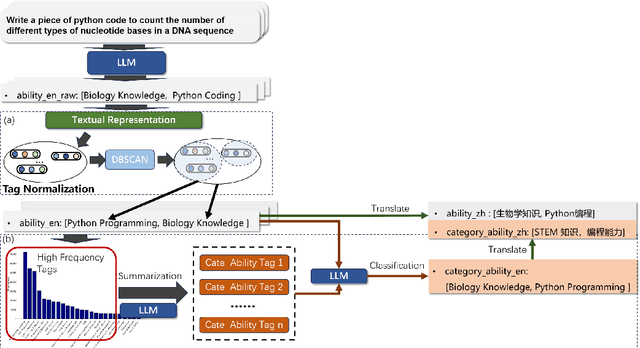Li Du
School of Electronic Science and Engineering, Nanjing University
Encyclo-K: Evaluating LLMs with Dynamically Composed Knowledge Statements
Dec 31, 2025Abstract:Benchmarks play a crucial role in tracking the rapid advancement of large language models (LLMs) and identifying their capability boundaries. However, existing benchmarks predominantly curate questions at the question level, suffering from three fundamental limitations: vulnerability to data contamination, restriction to single-knowledge-point assessment, and reliance on costly domain expert annotation. We propose Encyclo-K, a statement-based benchmark that rethinks benchmark construction from the ground up. Our key insight is that knowledge statements, not questions, can serve as the unit of curation, and questions can then be constructed from them. We extract standalone knowledge statements from authoritative textbooks and dynamically compose them into evaluation questions through random sampling at test time. This design directly addresses all three limitations: the combinatorial space is too vast to memorize, and model rankings remain stable across dynamically generated question sets, enabling reliable periodic dataset refresh; each question aggregates 8-10 statements for comprehensive multi-knowledge assessment; annotators only verify formatting compliance without requiring domain expertise, substantially reducing annotation costs. Experiments on over 50 LLMs demonstrate that Encyclo-K poses substantial challenges with strong discriminative power. Even the top-performing OpenAI-GPT-5.1 achieves only 62.07% accuracy, and model performance displays a clear gradient distribution--reasoning models span from 16.04% to 62.07%, while chat models range from 9.71% to 50.40%. These results validate the challenges introduced by dynamic evaluation and multi-statement comprehensive understanding. These findings establish Encyclo-K as a scalable framework for dynamic evaluation of LLMs' comprehensive understanding over multiple fine-grained disciplinary knowledge statements.
BEVUDA++: Geometric-aware Unsupervised Domain Adaptation for Multi-View 3D Object Detection
Sep 17, 2025Abstract:Vision-centric Bird's Eye View (BEV) perception holds considerable promise for autonomous driving. Recent studies have prioritized efficiency or accuracy enhancements, yet the issue of domain shift has been overlooked, leading to substantial performance degradation upon transfer. We identify major domain gaps in real-world cross-domain scenarios and initiate the first effort to address the Domain Adaptation (DA) challenge in multi-view 3D object detection for BEV perception. Given the complexity of BEV perception approaches with their multiple components, domain shift accumulation across multi-geometric spaces (e.g., 2D, 3D Voxel, BEV) poses a significant challenge for BEV domain adaptation. In this paper, we introduce an innovative geometric-aware teacher-student framework, BEVUDA++, to diminish this issue, comprising a Reliable Depth Teacher (RDT) and a Geometric Consistent Student (GCS) model. Specifically, RDT effectively blends target LiDAR with dependable depth predictions to generate depth-aware information based on uncertainty estimation, enhancing the extraction of Voxel and BEV features that are essential for understanding the target domain. To collaboratively reduce the domain shift, GCS maps features from multiple spaces into a unified geometric embedding space, thereby narrowing the gap in data distribution between the two domains. Additionally, we introduce a novel Uncertainty-guided Exponential Moving Average (UEMA) to further reduce error accumulation due to domain shifts informed by previously obtained uncertainty guidance. To demonstrate the superiority of our proposed method, we execute comprehensive experiments in four cross-domain scenarios, securing state-of-the-art performance in BEV 3D object detection tasks, e.g., 12.9\% NDS and 9.5\% mAP enhancement on Day-Night adaptation.
SQAP-VLA: A Synergistic Quantization-Aware Pruning Framework for High-Performance Vision-Language-Action Models
Sep 11, 2025Abstract:Vision-Language-Action (VLA) models exhibit unprecedented capabilities for embodied intelligence. However, their extensive computational and memory costs hinder their practical deployment. Existing VLA compression and acceleration approaches conduct quantization or token pruning in an ad-hoc manner but fail to enable both for a holistic efficiency improvement due to an observed incompatibility. This work introduces SQAP-VLA, the first structured, training-free VLA inference acceleration framework that simultaneously enables state-of-the-art quantization and token pruning. We overcome the incompatibility by co-designing the quantization and token pruning pipeline, where we propose new quantization-aware token pruning criteria that work on an aggressively quantized model while improving the quantizer design to enhance pruning effectiveness. When applied to standard VLA models, SQAP-VLA yields significant gains in computational efficiency and inference speed while successfully preserving core model performance, achieving a $\times$1.93 speedup and up to a 4.5\% average success rate enhancement compared to the original model.
AutoTIR: Autonomous Tools Integrated Reasoning via Reinforcement Learning
Jul 29, 2025Abstract:Large Language Models (LLMs), when enhanced through reasoning-oriented post-training, evolve into powerful Large Reasoning Models (LRMs). Tool-Integrated Reasoning (TIR) further extends their capabilities by incorporating external tools, but existing methods often rely on rigid, predefined tool-use patterns that risk degrading core language competence. Inspired by the human ability to adaptively select tools, we introduce AutoTIR, a reinforcement learning framework that enables LLMs to autonomously decide whether and which tool to invoke during the reasoning process, rather than following static tool-use strategies. AutoTIR leverages a hybrid reward mechanism that jointly optimizes for task-specific answer correctness, structured output adherence, and penalization of incorrect tool usage, thereby encouraging both precise reasoning and efficient tool integration. Extensive evaluations across diverse knowledge-intensive, mathematical, and general language modeling tasks demonstrate that AutoTIR achieves superior overall performance, significantly outperforming baselines and exhibits superior generalization in tool-use behavior. These results highlight the promise of reinforcement learning in building truly generalizable and scalable TIR capabilities in LLMs. The code and data are available at https://github.com/weiyifan1023/AutoTIR.
Scaling Towards the Information Boundary of Instruction Set: InfinityInstruct-Subject Technical Report
Jul 09, 2025



Abstract:Instruction tuning has become a foundation for unlocking the capabilities of large-scale pretrained models and improving their performance on complex tasks. Thus, the construction of high-quality instruction datasets is crucial for enhancing model performance and generalizability. Although current instruction datasets have reached tens of millions of samples, models finetuned on them may still struggle with complex instruction following and tasks in rare domains. This is primarily due to limited expansion in both ``coverage'' (coverage of task types and knowledge areas) and ``depth'' (instruction complexity) of the instruction set. To address this issue, we propose a systematic instruction data construction framework, which integrates a hierarchical labeling system, an informative seed selection algorithm, an evolutionary data synthesis process, and a model deficiency diagnosis with targeted data generation. These components form an iterative closed-loop to continuously enhance the coverage and depth of instruction data. Based on this framework, we construct InfinityInstruct-Subject, a high-quality dataset containing ~1.5 million instructions. Experiments on multiple foundation models and benchmark tasks demonstrate its effectiveness in improving instruction-following capabilities. Further analyses suggest that InfinityInstruct-Subject shows enlarged coverage and depth compared to comparable synthesized instruction datasets. Our work lays a theoretical and practical foundation for the efficient, continuous evolution of instruction datasets, moving from data quantity expansion to qualitative improvement.
CI-VID: A Coherent Interleaved Text-Video Dataset
Jul 02, 2025Abstract:Text-to-video (T2V) generation has recently attracted considerable attention, resulting in the development of numerous high-quality datasets that have propelled progress in this area. However, existing public datasets are primarily composed of isolated text-video (T-V) pairs and thus fail to support the modeling of coherent multi-clip video sequences. To address this limitation, we introduce CI-VID, a dataset that moves beyond isolated text-to-video (T2V) generation toward text-and-video-to-video (TV2V) generation, enabling models to produce coherent, multi-scene video sequences. CI-VID contains over 340,000 samples, each featuring a coherent sequence of video clips with text captions that capture both the individual content of each clip and the transitions between them, enabling visually and textually grounded generation. To further validate the effectiveness of CI-VID, we design a comprehensive, multi-dimensional benchmark incorporating human evaluation, VLM-based assessment, and similarity-based metrics. Experimental results demonstrate that models trained on CI-VID exhibit significant improvements in both accuracy and content consistency when generating video sequences. This facilitates the creation of story-driven content with smooth visual transitions and strong temporal coherence, underscoring the quality and practical utility of the CI-VID dataset We release the CI-VID dataset and the accompanying code for data construction and evaluation at: https://github.com/ymju-BAAI/CI-VID
Com$^2$: A Causal-Guided Benchmark for Exploring Complex Commonsense Reasoning in Large Language Models
Jun 08, 2025Abstract:Large language models (LLMs) have mastered abundant simple and explicit commonsense knowledge through pre-training, enabling them to achieve human-like performance in simple commonsense reasoning. Nevertheless, LLMs struggle to reason with complex and implicit commonsense knowledge that is derived from simple ones (such as understanding the long-term effects of certain events), an aspect humans tend to focus on more. Existing works focus on complex tasks like math and code, while complex commonsense reasoning remains underexplored due to its uncertainty and lack of structure. To fill this gap and align with real-world concerns, we propose a benchmark Com$^2$ focusing on complex commonsense reasoning. We first incorporate causal event graphs to serve as structured complex commonsense. Then we adopt causal theory~(e.g., intervention) to modify the causal event graphs and obtain different scenarios that meet human concerns. Finally, an LLM is employed to synthesize examples with slow thinking, which is guided by the logical relationships in the modified causal graphs. Furthermore, we use detective stories to construct a more challenging subset. Experiments show that LLMs struggle in reasoning depth and breadth, while post-training and slow thinking can alleviate this. The code and data are available at https://github.com/Waste-Wood/Com2.
Benchmarking and Pushing the Multi-Bias Elimination Boundary of LLMs via Causal Effect Estimation-guided Debiasing
May 22, 2025Abstract:Despite significant progress, recent studies have indicated that current large language models (LLMs) may still utilize bias during inference, leading to the poor generalizability of LLMs. Some benchmarks are proposed to investigate the generalizability of LLMs, with each piece of data typically containing one type of controlled bias. However, a single piece of data may contain multiple types of biases in practical applications. To bridge this gap, we propose a multi-bias benchmark where each piece of data contains five types of biases. The evaluations conducted on this benchmark reveal that the performance of existing LLMs and debiasing methods is unsatisfying, highlighting the challenge of eliminating multiple types of biases simultaneously. To overcome this challenge, we propose a causal effect estimation-guided multi-bias elimination method (CMBE). This method first estimates the causal effect of multiple types of biases simultaneously. Subsequently, we eliminate the causal effect of biases from the total causal effect exerted by both the semantic information and biases during inference. Experimental results show that CMBE can effectively eliminate multiple types of bias simultaneously to enhance the generalizability of LLMs.
UFO-RL: Uncertainty-Focused Optimization for Efficient Reinforcement Learning Data Selection
May 18, 2025Abstract:Scaling RL for LLMs is computationally expensive, largely due to multi-sampling for policy optimization and evaluation, making efficient data selection crucial. Inspired by the Zone of Proximal Development (ZPD) theory, we hypothesize LLMs learn best from data within their potential comprehension zone. Addressing the limitation of conventional, computationally intensive multi-sampling methods for data assessment, we introduce UFO-RL. This novel framework uses a computationally efficient single-pass uncertainty estimation to identify informative data instances, achieving up to 185x faster data evaluation. UFO-RL leverages this metric to select data within the estimated ZPD for training. Experiments show that training with just 10% of data selected by UFO-RL yields performance comparable to or surpassing full-data training, reducing overall training time by up to 16x while enhancing stability and generalization. UFO-RL offers a practical and highly efficient strategy for scaling RL fine-tuning of LLMs by focusing learning on valuable data.
Structural Entropy Guided Agent for Detecting and Repairing Knowledge Deficiencies in LLMs
May 12, 2025Abstract:Large language models (LLMs) have achieved unprecedented performance by leveraging vast pretraining corpora, yet their performance remains suboptimal in knowledge-intensive domains such as medicine and scientific research, where high factual precision is required. While synthetic data provides a promising avenue for augmenting domain knowledge, existing methods frequently generate redundant samples that do not align with the model's true knowledge gaps. To overcome this limitation, we propose a novel Structural Entropy-guided Knowledge Navigator (SENATOR) framework that addresses the intrinsic knowledge deficiencies of LLMs. Our approach employs the Structure Entropy (SE) metric to quantify uncertainty along knowledge graph paths and leverages Monte Carlo Tree Search (MCTS) to selectively explore regions where the model lacks domain-specific knowledge. Guided by these insights, the framework generates targeted synthetic data for supervised fine-tuning, enabling continuous self-improvement. Experimental results on LLaMA-3 and Qwen2 across multiple domain-specific benchmarks show that SENATOR effectively detects and repairs knowledge deficiencies, achieving notable performance improvements. The code and data for our methods and experiments are available at https://github.com/weiyifan1023/senator.
 Add to Chrome
Add to Chrome Add to Firefox
Add to Firefox Add to Edge
Add to Edge